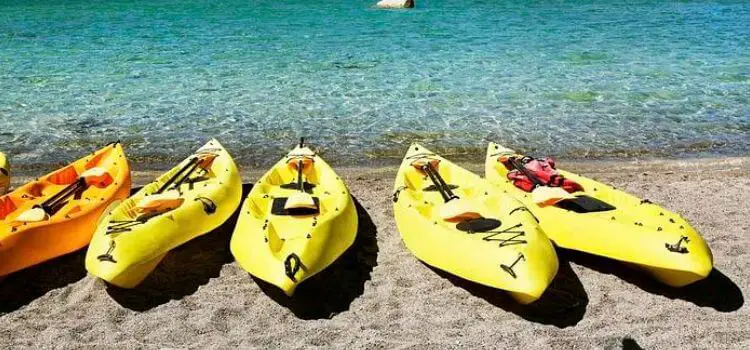As an Amazon Associates, I earn from quality purchases.
Kayaks and Jon boats are two popular choices for different water activities. But they have distinct features and advantages. In this article, to truly grasp the intricacies of Kayak vs Jon Boat, we’ll explore their features, maneuverability, durability, and other important factors.
In short, kayaks are sleek, narrow watercraft. They can easily navigate tight spaces, including rivers and narrow waterways. On the other hand, Jon boats are wider and more stable. They offer ample space for fishing or carrying equipment. Both possess distinct advantages and serve different purposes. Understanding their differences will help you determine which one aligns better with your specific requirements.
Let’s set sail and navigate through the compelling world of kayaks and Jon boats!
What is a Kayak?

A kayak is a small, narrow watercraft that is typically propelled by a double-bladed paddle. They originated from Inuit cultures. Kayaks were originally used for hunting and transportation in icy waters. Today, kayaks come in various types, including sit-on-top, sit-inside, touring, and recreational kayaks.
Advantages of Kayaks:
- Kayaks are highly maneuverable, navigating narrow areas and shallow waters easily.
- Their compact size allows kayaks to reach remote and inaccessible places.
- Kayaking provides a full-body workout, improving strength and cardiovascular health.
- Kayaks allow for a silent approach to wildlife and nature observation.
- Kayaks typically offer a more budget-friendly option in contrast to alternative watercraft.
- They are lightweight and easy to transport.
Disadvantages of Kayaks:
- Kayaks have limited storage capacity for gear and supplies.
- Kayaks are slower than motorized watercraft.
- Traditional kayaks can be less stable, requiring practice to maintain balance.
- Kayakers are susceptible to weather conditions and may experience getting soaked.
- Most kayaks accommodate one or two people.
- Kayaking requires skill and technique to paddle effectively.
What is a Jon Boat?
Jon boats, also known as flat-bottom boats, are characterized by their flat, squared-off bows and shallow drafts. These boats were initially designed for use in shallow, calm waters and were used for fishing and transportation.
Advantages of Jon Boats:
- Jon boats provide a stable platform for fishing, hunting, and other activities.
- They have ample space for passengers, gear, and equipment.
- Jon boats can be used for various purposes like fishing, hunting, and work.
- Their design allows them to navigate shallow waters and reach inaccessible areas.
- Jon boats are made from durable materials, such as aluminum, for rugged use.
- Owners can easily customize Jon boats to suit their specific needs.
Disadvantages of Jon Boats:
- Jon boats are less maneuverable than smaller watercraft like kayaks.
- They tend to be slower, especially with larger motors.
- Jon boats require trailers for transport, which may be less convenient.
- They need sufficient space for storage when not in use.
- Some models with gasoline engines can have a higher environmental impact.
- Jon boats, especially larger ones with additional features, can be more expensive.
Kayak vs Jon Boat: Key Features
Here’s a table comparing the key features of kayaks and Jon Boats:
Key Features | Kayaks | Jon Boats |
Size and Capacity | Smaller, 1-2 passengers | Larger, more passengers |
Maneuverability | Highly maneuverable | Less maneuverable |
Stability | Less stable | More stable |
Carrying Capacity | Limited storage space | Ample storage space |
Speed | Slower | Faster with larger motors |
Accessibility | Can access narrow waters | Limited in shallow areas |
Transportation | Portable, no trailer needed | Requires trailer |
Customization | Limited customization options | More flexibility for customization |
Cost | Generally more affordable | Can be more expensive |
Kayak vs Jon Boat: Key Comparisons

Comparing Size
When it comes to size, Jon boats are generally larger than kayaks. Jon boats can range from 10 to 24 feet in length, while kayaks are usually between 8 and 18 feet long. The larger size of Jon boats provides more space for passengers, gear, and equipment.
The size difference also affects stability and maneuverability. Kayaks are more agile and can navigate tight spaces and narrow waterways. Jon boats, on the other hand, offer better stability, especially when carrying heavier loads.
Water Activities
Kayaks are versatile watercraft suitable for various activities. They excel in recreational paddling, touring, and exploring calm waters, such as lakes and rivers. Kayaks are also popular for fishing due to their maneuverability and ability to access shallow areas.
Jon boats, with their larger size and stability, are great for activities that require more gear and equipment. They are commonly used for fishing, hunting, and even as workboats. Jon boats can handle rougher waters, making them suitable for larger bodies of water, including lakes and coastal areas.
Portability
Portability is a crucial factor to consider when choosing a watercraft. Kayaks are lightweight and compact, making them easy to transport. They can be carried on car roof racks or even folded into a backpack for convenient travel.
Jon boats, being larger and heavier, require a trailer for transportation. While this limits their portability compared to kayaks, it allows for easier launching and recovery from boat ramps.
Storage
Storage options for kayaks and Jon boats also differ. Kayaks can be stored in a garage, or shed, or hung on wall-mounted racks. Some models even allow for stacking multiple kayaks to save space. In contrast, Jon boats require more substantial storage space, such as a boat dock or a larger storage facility.
Maneuverability and Speed
When it comes to maneuverability, kayaks take the lead. Their sleek designs, lightweight construction, and specialized hull shapes allow for swift and agile movement. Whether you’re tackling winding rivers or intricate mangrove forests, a kayak will effortlessly glide through tight spaces. It will ensure you reach those hidden gems that others may miss.
On the other hand, Jon boats, while not as nimble as kayaks, offer a different kind of stability and control. Their flat-bottomed design ensures excellent stability even in calm waters. They allow you to stand up and cast your fishing line without fear of capsizing. If you plan on embarking on leisurely fishing trips or navigating large bodies of water, a Jon boat might be the better option.
Versatility and Use Cases
When it comes to versatility, kayaks are hard to beat. Kayaks will cover you in almost every situation. It does not matter if you’re embarking on a solo adventure, planning a fishing expedition, or even exploring the exhilarating world of whitewater rafting. Their ability to adapt to different environments and cater to various activities makes them a popular choice among outdoor enthusiasts.
Jon boats may not offer the same level of versatility as kayaks. But they excel in accommodating larger groups and heavier loads. Their spacious decks and higher weight capacities allow you to carry additional gear, making them ideal for fishing trips, camping excursions, or leisurely cruises with friends and family.
Stability
Kayaks are designed for stability. They offer a lower center of gravity and a snug fit for the paddler. This design makes them less likely to tip over. providing a safe experience for beginners and experienced paddlers alike.
Jon boats, with their flat and wide hull, offer excellent stability even when standing up or moving around. This makes them a safe choice for activities like fishing, as they provide a steady platform for casting and reeling.
Speed:
If you’re in a hurry to reach your favorite fishing spot or simply want to satisfy your need for speed, the kayak takes the lead in this race. Due to their streamlined design and the ability to paddle with both hands, kayaks offer excellent speed and agility. You’ll be zipping across the water like a waterborne cheetah, leaving the Jon Boat in your wake.
On the other hand, Jon Boats are more leisurely cruisers. Their design prioritizes stability over velocity. However, if you add an outboard motor to your Jon Boat, you can enjoy a relaxed, effortless ride while your kayak friends are still busy paddling away. The choice between speed and tranquility is in your hands!
Cost and Maintenance
When it comes to cost, kayaks generally offer a more affordable option. Depending on the type and features, kayak prices can range from a few hundred to a few thousand dollars. Maintenance is also minimal, with occasional cleaning and inspection of the hull and accessories.
Jon boats, due to their larger size and often additional features, tend to be more expensive. Prices for Jon boats can vary significantly, from a few thousand to tens of thousands of dollars. Maintenance includes regular checks on the motor, hull, and electrical components.
Environmental Impact
Considering the environmental impact is crucial for responsible boating. Kayaks have a minimal environmental footprint, as they do not rely on fuel or emit pollutants. They have a lower impact on waterways, making them a more eco-friendly choice.
Jon boats, especially those powered by gasoline engines, have a higher environmental impact due to fuel consumption and emissions. However, newer models with more efficient engines and proper maintenance can reduce the impact.
Comfort and Amenities
Comfort and amenities play a significant role in watercraft selection. Kayaks offer different seating options, including adjustable seats and backrests for enhanced comfort. Accessories such as dry storage compartments and fishing rod holders can be added for convenience.
Jon boats provide more cabin space and seating options, allowing for a more comfortable experience during longer trips. They can be equipped with accessories like fishing platforms, live wells, and even small cabins for overnight stays.
Fishing
Fishing enthusiasts often consider both kayaks and Jon boats. Kayaks provide a stealthier approach and can access tight spaces near shorelines and in shallow waters. They are suitable for solo fishing adventures and casting in hard-to-reach areas.
Jon boats offer more space for fishing gear and multiple anglers. They provide stability for standing and casting, making them popular for larger fishing parties or when targeting larger game fish.
Safety
Safety is paramount when engaging in water activities. For kayaks, it’s essential to wear a personal flotation device (PFD) and follow proper safety guidelines. Being close to the water’s surface, kayakers should be mindful of changing weather conditions and potential capsizing risks.
Jon boats, with their larger size and stability, offer a higher level of safety. However, wearing a PFD is still crucial, especially when operating in open waters or with heavy loads. Proper knowledge of boating regulations and safety practices is essential for both watercraft.
Some Common Queries Regarding Jon Boat:

Are Jon Boats Good for Shallow Water?
Yes, Jon boats are highly regarded for their performance in shallow water conditions. Their shallow draft and flat-bottom design make them well-suited for navigating through marshes, rivers, and lakes with low water depths.
This feature allows boaters to access areas that might be inaccessible to other types of boats, providing an excellent opportunity for exploring and fishing in shallow waters.
Do Jon Boats Tip Over Easily?
While Jon boats are generally stable, the risk of tipping over does exist, especially if caution is not exercised. Proper weight distribution is crucial to maintaining stability and reducing the risk of tip-overs.
When passengers shift their weight abruptly or when the boat encounters sudden changes in water conditions, there is a higher likelihood of tipping. By ensuring an even distribution of weight and avoiding sudden movements, the risk of tipping over can be significantly minimized.
Can You Stand Up in a Jon Boat?
Yes, one of the advantages of a Jon boat is its stability, which allows occupants to stand up comfortably. This is particularly beneficial for activities such as fishing, casting, or simply enjoying the view.
However, it’s important to note that maintaining balance is key to preventing accidents. Distributing weight evenly and avoiding sudden movements will help ensure stability and reduce the chances of tipping over.
Is It Hard to Row a Jon Boat?
Rowing a Jon boat is generally not difficult, thanks to its flat-bottom design. This design allows for easy maneuvering through calm waters, making rowing a relatively smooth and enjoyable experience. However, it’s worth considering environmental factors such as currents and winds.
Rowing against strong currents or winds can require more effort and skill, so it’s important to assess the conditions and your capabilities before embarking on rowing adventures in a Jon boat.
Can You Go Offshore in a Jon Boat?
Jon boats are primarily designed for calm and shallow waters, so going offshore in a Jon boat is not typically recommended. Their flat-bottom hulls and low freeboard make them less suitable for handling rough water conditions that are often encountered in offshore areas.
It’s important to prioritize safety and choose a boat that is specifically designed and equipped for offshore use if you plan to venture into open waters.
Why Put a Jack Plate on a Jon Boat?
A jack plate is an accessory that can be added to a Jon boat to enhance its performance. It is typically installed between the boat’s transom and the outboard motor. The main purpose of a jack plate is to allow for vertical adjustment of the outboard motor’s height.
This adjustment provides several benefits, including improved maneuverability, better shallow water navigation, and increased overall efficiency. By raising the outboard motor higher on the transom, the boat can navigate in shallower waters without the risk of the motor hitting the bottom.
This is particularly useful when exploring marshes, flats, or other areas with low water depths. The increased motor height also helps optimize the boat’s performance by reducing drag and improving fuel efficiency.
Which is Right for You?
Choosing between a kayak and a Jon boat ultimately depends on your preferences, needs, and the type of water activities you plan to pursue. Consider where you will primarily use the watercraft, the number of passengers, and the gear you’ll carry.
If you enjoy solo adventures, exploring narrow waterways, and prefer a more portable and cost-effective option, a kayak may be the ideal choice. On the other hand, if you’re looking for more space, stability, and the ability to carry heavier loads for fishing or group outings, a Jon boat might be the better option.
Conclusion
In conclusion, both kayaks and Jon boats offer unique advantages and cater to different preferences and water activities. Assess your requirements, consider the pros and cons of each watercraft, and make an informed decision based on your needs and budget. Remember to prioritize safety and follow proper boating practices for a rewarding and enjoyable experience on the water.
FAQs
Q: Why is kayak fishing better than a boat?
Kayak fishing offers several advantages over fishing from a traditional boat. Firstly, kayaks are much quieter and more maneuverable, allowing you to access shallow and hard-to-reach fishing spots.
Secondly, kayaks have a lower profile, making them less visible to fish and increasing your chances of a successful catch. Additionally, kayak fishing is a more affordable option compared to owning and maintaining a boat, making it accessible to a wider range of fishing enthusiasts.
Q: Is it worth buying a Jon boat?
Whether a Jon boat is worth buying depends on your specific needs and preferences. Jon boats excel in shallow water navigation and provide stability for various recreational activities like fishing and hunting. They are also relatively affordable compared to other types of boats. If you frequently venture into calm and shallow water environments and prioritize stability and affordability, a Jon boat can be a worthwhile investment.
However, if you plan to navigate rough waters, require higher speeds, or prioritize cabin space and protection from the elements, a different type of boat might be more suitable for your needs.
Q: Are kayaks safer than Jon boats?
Safety depends on various factors, such as usage, conditions, and individual precautions. Both kayaks and Jon boats can be safe if operated responsibly and with the necessary safety measures in place.
Q: Can I fish from a kayak?
Yes, kayaks are popular for fishing due to their maneuverability and access to shallow areas. They provide a unique and enjoyable fishing experience.
Q: Do Jon boats require a trailer for transport?
Yes, due to their larger size and weight, Jon boats usually require a trailer for transportation. This allows for easier launching and recovery from boat ramps.
Q: Are kayaks suitable for beginners?
While kayaks can be used by beginners, some models may have a learning curve in terms of stability. It’s recommended to start with wider, more stable kayaks until you gain confidence and experience.
Q: How much maintenance do Jon boats require?
Jon boats require regular maintenance, including engine checks, hull cleaning, and electrical system inspections. Following the manufacturer’s guidelines and proper upkeep will ensure longevity and optimal performance.

Leave a Reply